Zhejiang University
Coordinates: 30°15′49″N 120°07′15″E / 30.26361°N 120.12083°E
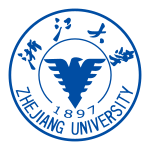 | |
| Motto | 求是创新[1] |
|---|---|
Motto in English | Seeking the Truth and Pioneering New Trails[2] |
| Type | Public |
| Established | 1897 |
| President | Wu Zhaohui (吴朝晖) |
| Party Secretary | Zou Xiaodong (邹晓东) |
Academic staff | 3,350 |
| Students | 45,678[3] |
| Undergraduates | 23,302 |
| Postgraduates | 22,376 |
| 8,577 | |
| Location | Hangzhou, Zhejiang, China |
| Campus | Urban, 4.5 km² |
| Colors | Blue and red |
| Affiliations | APRU, WUN, C9 |
| Website |
zju.edu.cn (in Chinese) zju.edu.cn/english (in English) |
 | |
Zhejiang University (ZJU, also known as Che Kiang University; simplified Chinese: 浙江大学; traditional Chinese: 浙江大學; pinyin: Zhèjiāng Dàxué; Wade–Giles: Che-Chiang-ta-hsüeh), sometimes referred to as Zhèdà (浙大), is an elite C9 League university in Zhejiang province.[4] It is also a Chinese Ministry of Education Class A Double First Class University.[5] Founded in 1897, Zhejiang University is one of China's oldest, most selective and most prestigious institutions of higher education. It is also a member of the Yangtze Delta Universities Alliance and the Association of Pacific Rim Universities.
The university campus is located in the city of Hangzhou. Zhejiang University Library's collection contains about 7 million volumes,[6] making it one of China's largest academic libraries.[7]
History

Qing Dynasty
In 1897, then-mayor of Hangzhou, Lin Qi (traditional Chinese: 林啟; simplified Chinese: 林启; pinyin: Lín Qǐ; Wade–Giles: Lin Ch'i) established the "Qiushi Academy/Ch'iu Shih Academy" (求是書院; 求是书院; Qiúshì Shūyuàn; Ch'iu-shih-shu-yüan).[8] Lin studied the Western higher education system and applied it to the Qiushi Academy. The Ch'iu-shih Academy was renamed to Chekiang College (浙江大學堂; 浙江大学堂; Zhèjiāng Dàxuétáng) in 1902, and to Chekiang Higher Institutes in 1903.
A second institution that factored into the early history of Zhejiang University was Yuying Xuetang (Yuying School or Yuying College), established in 1902. This was renamed to Yuying Yishu (Yuying Public School), and then to Yuying Academy. In 1911, Yuying Academy became Zhijiang Xuetang (Zhijiang College) and moved to Qinwang Hill (秦望山), outside of Hangzhou.
1912–1937
In 1912, Zhejiang Medical School was established, later developing into Zhejiang Provincial Medical College and becoming part of Zhejiang University.
In 1927, some schools and colleges (e.g. industrial and agricultural colleges/schools) were merged into the Qiushi Academy. Then the name of the enlarged school was changed to "National Third Sun Zhongshan University" (or, National Third Sun Yat-sen University), after Sun Yat-sen. On April 1, 1928, it was renamed "Che Kiang University" (now Zhejiang University from the pinyin name), and in the same year, "National" was added and it became "National Che Kiang University" (國立浙江大學; 国立浙江大学; Guólì Zhèjiāng Dàxué).
War period, 1937–1949
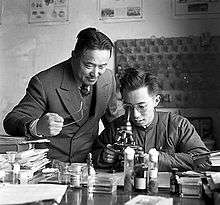
In the latter half of 1937, the Second Sino-Japanese War broke out, and due to the invading Imperial Japanese Army, the university evacuated from Hangzhou to Guizhou until 1946, after the war ended.
Reputed as "Cambridge of the East" by Joseph Needham (twice visited ZJU in 1944) in China's modern history of higher education, National Che Kiang University's was consistently ranked as among top 3 in the nation during that time.
During this period, the National Che Kiang University was praised as one of the Four most Prominent Universities in the Republic China (民國四大名校), along with National Central University, National Southwestern Associated University, and National Wuhan University.
1952–1998
Zhejiang University was split up into a number of single-discipline colleges during the 1952 readjustment of China's Tertiary Education System. Its schools of arts and sciences either went to former Hangzhou University or joined with Fudan University. Its medical and pharmaceutical schools formed Zhejiang Medical University. Its agricultural and horticultural schools went to establish Zhejiang Agricultural University.
1952~1953, Its chemical engineering departments, and some the other technological parts went to former Hangzhou Chemical Engineering School (now Zhejiang University of Technology, ZJUT). And the dean Li Shouheng, who was one of the main founders of China's modern chemical engineering, was pointed to be the first president of ZJUT.
After 1998
In 1998, with the approval of the State Council, the new Zhejiang University was established as a combination of four major universities that had grown up in Hangzhou over the previous half-century, namely Zhejiang University, Hangzhou University, Zhejiang Agricultural University and Zhejiang Medical University.
On September 21, 2006, Chinese billionaires Duan Yongping (Zhejiang University alumnus) and Ding Lei (Zhejiang native) donated together a one-time endowment of 40 million US dollars to Zhejiang University. 30 million USD was from Duan with 10 million from Ding. It was the largest private one-off endowment to a university in Mainland China.[9] A ceremony was held at the newly founded Zijin'gang Campus to receive the donation.[10]
Academics
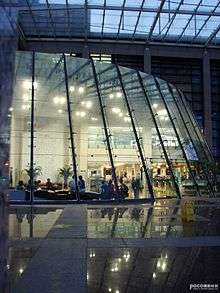
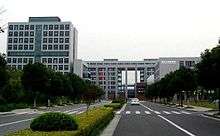
Zhejiang University is a comprehensive research university with national and international impact. Research at Zhejiang University spans 12 academic disciplines: agriculture, art, economics, education, engineering, history, law, literature, management, medicine, natural sciences, and philosophy. In the Essential Science Indicator (ESI) rankings of 22 disciplines, Zhejiang University ranks among the top 1% in 15 disciplines and is listed in the top 100 of the world’s academic institutions in 4 disciplines.
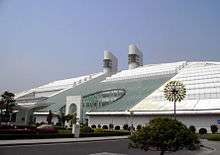
With five campuses, namely Zijin'gang, Yuquan, Xixi, Huajiachi and Zhijiang campuses, Zhejiang University encompasses an area of 4.5 square kilometers with school buildings covering 1.94 million square meters of floor space. The university library holds a collection of more than 6.27 million volumes. In addition, Zhejiang University has 7 high-level affiliated hospitals.
Zhejiang University focuses on assiduous study and research, and science and technological innovation. It has launched a number of international high-end academic platforms and gathered masters, scholars and high-level research teams in various disciplines. In recent years, Zhejiang University maintains a leading position in China in output indicators including publications, patents, etc., and has made abundant important achievements in science, technology, humanities and social sciences. Zhejiang University always takes initiative in catering for national and regional needs and exerts itself to become an influential high-level source of innovation and a pool of talents. In 2011, research fund at Zhejiang University amounted to 2.817 billion Yuan. More than a hundred projects under research have each secured a grant of more than 10 million.
Faculty
Among its approximate 3,100 standing faculty [11] members, more than 1,200 faculty members hold the title of professor. The faculty includes: 14 members of the Chinese Academy of Sciences, 13 members of the Chinese Academy of Engineering, 48 scholars in the national Recruitment Program of Global Experts, 20 chief scientists of national 973 projects, 81 Changjiang (Yangtze River) Award winners, and 88 recipients of the awards from the National Science Fund for Distinguished Young Scholars. Zhejiang University also has some prominent foreigners, who joined its rank as faculty. This include Nobel Laureate Michael Levitt, who joined Zhejiang University Department of Chemistry in 2018.[12]
Student body
At present, there are a total of 45,678 full-time students enrolled at Zhejiang University, including 22,376 graduate students, 8577 Ph.D candidates, and 23,302 undergraduates. In addition, there are 3,407 international students currently attending Zhejiang University.
Rankings
Zhejiang University is consistently ranked among China's top universities.[13][14]
| University rankings | |
|---|---|
| Global | |
| ARWU World[15] | 67 |
| Times World[16] | 177 |
| QS World[17] | 68 |
| Regional | |
| Times Asia[18] | 19 |
| QS Asia[19] | 21 |
| National | |
| BCUR China[20] | 3 |
Campuses
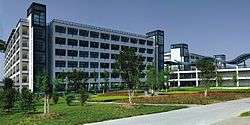

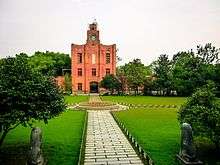

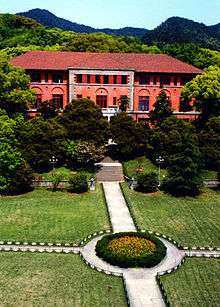
Zhejiang University has seven campuses:
Yuquan Campus
The main campus of engineering. It was the main campus of Zhejiang University until Zijin'gang Campus was built in 2002.
Xixi Campus
The campus of arts and sciences. It was previously Hangzhou University before its merge into Zhejiang University in 1998.
Haining International Campus
This new campus (simplified Chinese: 海宁国际校区; traditional Chinese: 海寧國際校區) is located in the Zhejiang city of Haining.[21] Clusters of international cooperative partners and institutions reside on this site, which opened in 2016 as part of Zhejiang University. The Haining International Campus is home to the Zhejiang University-University of Edinburgh Institute.
Huajiachi Campus
The campus of agriculture. It was previously Zhejiang Agricultural University before it's merged into Zhejiang University, and also where the old Huajiachi Campus of "National Che Kiang University" located. This campus has been the oldest one of Zhejiang University.
A part of it has already been sold, and the College of Agriculture and Biotechnology and the College of Animal Sciences have moved to Zijin'gang Campus.
Zhijiang Campus
The old campus of mathematics and related theoretical sciences, at present the main part of which is Guanghua Law School. It was the campus of Zhijiang University before 1952.
Zijin'gang Campus
New and the biggest campus, the headquarters, campus of medical school, located in the northwest of Hangzhou. Most of the first year and second year undergraduate students live in this campus.
Zhoushan Campus
This new campus (舟山校区; 舟山校區) opened in 2015, and serves as the campus of the Ocean College, and is located in the Zhejiang city of Zhoushan.[22]
Organization
Under the direct administration of China's Ministry of Education, the new Zhejiang University is a key comprehensive university whose fields of study cover eleven branches of learning, namely philosophy, literature, history, education, science, economics, law, management, engineering, agriculture, and MBBS.[23] The university now has 110 specialties for undergraduate studies, and it is entitled to confer master's degrees in 264 programs and doctoral degrees in 181 programs. Under its administration, there are 13 National Key Laboratories, 2 National Engineering Research Centers and 3 National Engineering Technology Centers. Besides, it has set up 24 national key specialties and 39 post-doctoral stations.
Affiliated institutes
- Zhejiang California International NanoSystems Institute (ZCNI)
- Center of Mathematical Sciences, Zhejiang University
- Research Institute of Zhejiang University-Taizhou
- China Academy of West Region Development
- Qiushi Academy for Advanced Studies, Zhejiang University
- Zhejiang University Innovation institute(ZII), international
- Social Science Experiment Center of Zhejiang University
- Life Science Institute, Zhejiang University
- Institute of Environment Pollution Control and Treatment, Zhejiang University
- Academy of Financial Research, Zhejiang University
- Ocean Research Center of Zhoushan, Zhejiang University
- International Design Institute, Zhejiang University
- Academy of Global Zhejiang Entrepreneurs, Zhejiang University
- Institute of Translational Medicine, Zhejiang University
- Public Policy Research Institute of Zhejiang University
- Institute of Genetics, Zhejiang University
- Zhejiang University Institute for Advanced Study in Humanities and Social Sciences
- Center for Correlated Matter(CCM), Zhejiang University
- Research Center of Public Service and Performance Evaluation, Zhejiang University
- Institute for Fusion Theory and Simulation (IFTS), Zhejiang University
Affiliated hospitals
Zhejiang University has seven affiliated hospitals
- The First Affiliated Hospital, Zhejiang University School of Medicine
- The Second Affiliated Hospital, Zhejiang University School of Medicine
- Sir Run Run Shaw Hospital (donated by Sir Run Run Shaw)
- The Fourth Affiliated Hospital, Zhejiang University School of Medicine
- The Women's Hospital, Zhejiang University School of Medicine
- The Children's Hospital, Zhejiang University School of Medicine
- Zhejiang Stomatology Hospital (also named Zhejiang University Affiliated Stomatology Hospital)
Affiliated colleges
- Zhejiang University City College (Hangzhou)
- Ningbo Institute of Technology, Zhejiang University (Ningbo)
Others
- High-tech park of Zhejiang University in Hangzhou
- High-tech park of Zhejiang University in Ningbo
- Botanical Garden of Zhejiang University
Traditions
Anniversary
May 21 is the Home-coming Day (Chinese: 校庆) of Zhejiang University. May 21, 2017 was the 120th anniversary.
Dec 31 is the Student Day (Chinese: 学生节) of Zhejiang University.
Alma mater (university anthem)
The only version of Zhejiang University Anthem is in Classical Chinese. The English translation of the words of the Zhejiang University Anthem is as follows:[24]
- The vast sea contains all streams, all rivers;
- Great learning connects Heaven and Earth.
- Metaphysical is Tao; instrumental is Tool.
- Rites tell people apart; Music gets them together.
- To know their relations would make us ever brighter.
- There's a national university standing by River Qiantang,
- Whose eternal philosophy is seeking truth from facts.
- Progressive education can produce those able to govern;
- Never say you know the essence, let alone the truth.
- Reform is necessary, and renewal is a must;
- To be a vanguard is to be both creative and innovative;
- Dear young vanguards should be clear of the principles.
- Be devoted to study, deep in thinking and good in understanding;
- We offer arts, science, agriculture, technology, and beyond;
- It needs you to know them all – their origins and applications.
- To become successful people will be like true gold to be made;
- To give up fractional views we’re of far sight and broad mind;
- To rejuvenate our great nation is to harmonize the whole world.
People
Notable alumni
See List of Zhejiang University alumni
- Chen Tianhua - Qiushi Academy and the member of Chinese United League and reporter of The People's Daily
- Chen Duxiu – the co-founder, the 1st General Secretary and 1st Chairman of Communist Party of China
- Xie Xuren – Minister of Finance of the People's Republic of China
- Hu Qiaomu – the 1st President of Chinese Academy of Social Sciences, President of Xinhua News Agency
- Huang Fu – President and Premier of the Republic of China
- Jiang Menglin – Minister of Education (1928–1930) of the Republic of China
- Chen Yi – Chief Executive and Garrison Commander of Taiwan
- Zhang Xinsheng – Chairman of UNESCO’s Executive Board
- Ye Duzheng – meteorologist, State Preeminent Science and Technology Award winner 2005
- Xu Guangxian – chemist, State Preeminent Science and Technology Award winner 2009
- Hsiao-Lan Kuo – meteorologist, Carl-Gustaf Rossby Research Medal winner 1970
- Xie Xuejing – geochemist, AAG Gold Medal winner 2007
- Lin Fanghua – mathematician, Bôcher Memorial Prize winner 2002
- Hu Hesheng – mathematician, Noether Lecturer 2002
- Xu-Jia Wang – mathematician, Australian Mathematical Society Medal winner 2002
- T. Tony Cai – statistician, COPSS Presidents' Award winner 2008
- Tsung-Dao Lee – physicist, Nobel Prize laureate (physics, 1957)
- Chien-Shiung Wu – physicist, Wolf Prize laureate (physics, 1978)
- Xu Liangying – physicist, Andrei Sakharov Prize recipient 2008
- Chen Hang – horticulturist, Veitch Memorial Medal winner 1990
- Kun-Liang Guan – biochemist, MacArthur Award winner 1998
- Tao-Chiuh Hsu – biologist, the 13th President of American Society for Cell Biology
- Yao Zhen – biologist, the 1st President of Asian-Pacific Organization for Cell Biology
- Qiu Fazu – surgeon, Bundesverdienstkreuz recipient 1985
- Wu Guanzhong – painter, Ordre des Arts et des Lettres recipient 1991
- Lu Yongxiang – President of Chinese Academy of Science
- Ding Zhongli – Vice-president of Chinese Academy of Science
- Pan Yunhe – Vice-president of Chinese Academy of Engineering
- Pan Jiazheng – Vice-president of Chinese Academy of Engineering
- Wang Xufeng – writer, Mao Dun Literature Prize winner 2000
- Min Zhu – co-founder and former President and CTO of WebEx
- Cha Chi Ming – industrialist, entrepreneur, philanthropist, Grand Bauhinia Medal winner 1997
- Zhu Yanfeng – President of First Automobile Works
- Wang Jianzhou – Chairman & CEO of China Mobile
- Wang Tianpu – President of Sinopec
- Shi Zhengrong – Founder & CEO of Suntech Power
- Zhu Qinan – shooter, 10 m Air Rifle olympic champion, 2004 Athens
- Zhou Suhong – volleyball player, 2003 World Cup and 2004 Athens Olympic Games team champion.
Notable faculty
- Shing-Tung Yau – Fields Medalist, founder and director of the Center of Mathematical Sciences, Zhejiang University
- Shiing-Shen Chern – Wolf Prize laureate, former director and advisor of the Center of Mathematical Sciences
- Chien-Shiung Wu – Wolf Prize laureate
- Ren Mei'e – Victoria Medal winner 1986, former professor and dean of the Department of Geology
- Wu Wenjun – Shaw Prize laureate 2006, former teacher of Hangzhou University
- Liu Chen – Hannes Alfvén Prize recipient 2008, professor and director
- Su Buqing - mathematician, co-founder of Chen-Su School, former dean of the Department of Mathematics, former provost of Zhejiang University
- Chen Jiangong - mathematician, co-founder of Chen-Su School, former dean of the Department of Mathematics
- Bei Shizhang – biologist, former co-founder and professor of the Department of Biology
- Tan Jiazhen – geneticist, former professor of the Department of Biology, former dean of the College of Science
- Chang Chi-yun – historian, geologist, politician
- Coching Chu – meteorologist, geologist, former president of Zhejiang University
- Ma Yinchu - economist, former president of Zhejiang University
- Jiang Menglin – educator, former president of Zhejiang University
- Jin Au Kong – Electromagnetist, founder and former president of the Electromagnetics Academy
- Jin Yong – novelist, former dean of the Faculty of Arts and Humanities
- Qian Sanqiang – physicist
- Kan-Chang Wang – physicist, discover of the Sigma baryon, proposed neutrino detection which led to neutrino discovery, former dean of the Department of Physics
- Xia Yan – playwright, screenwriter
See also
References
- ↑ 校训. Archived from the original on December 25, 2016. Retrieved July 13, 2014.
- ↑ "Introduction to Zhejiang University". Archived from the original on December 25, 2016. Retrieved June 20, 2014.
- ↑ "学校概况" 学校概况 - 浙江大学 [University overview - Zhejiang University]. Zhejiang University. Archived from the original on May 23, 2012. Retrieved June 30, 2014.
- ↑ "Best universities in China 2018". Times Higher Education. 6 September 2017.
- ↑ 教育部 财政部 国家发展改革委 关于公布世界一流大学和一流学科建设高校及建设 学科名单的通知 [Notice from the Ministry of Education and other national governmental departments announcing the list of double first class universities and disciplines]. Ministry of Education.
- ↑ 搜狐网 – 高校门户网 – 浙江大学. Sohu Education. Archived from the original on May 11, 2008. Retrieved May 11, 2008.
- ↑ Libraries in China
- ↑
- ↑ 网易新闻中心:段永平、丁磊4000万美元捐赠浙江大学 [Duan Yongping and Ding Lei donates 40 million US dollar to Zhejiang University]. 163.com news. 2006-09-21.
- ↑ Mr. Yongping Duan and Mr. Lei Ding Donated 40 Million US Dollars
- ↑ http://hr.zju.edu.cn/en/redir.php?catalog_id=10017&object_id=13
- ↑ http://www.zju.edu.cn/english/2018/0416/c19573a811129/page.htm
- ↑ Wu, Shulian. "Top 10 Chinese universities in overall strength". China.org.
- ↑ University Rankings Summary: Zhejiang University
- ↑
- ↑ World University Rankings 2018
- ↑ QS World University Rankings 2018
- ↑ Asia University Rankings 2017
- ↑
- ↑ Best Chinese Universities Ranking, Overall Ranking - 2018
- ↑ "Faculty and Staff Moved to Haining Campus | International Campus Zhejiang University". www.intl.zju.edu.cn. Retrieved 2016-10-12.
- ↑ 浙江大学舟山校区. Retrieved 29 December 2015.
- ↑ "Zhejiang University". CUCAS. Retrieved 24 August 2015.
- ↑ Zhejiang University Logo, Song, and etc. Archived 2010-04-27 at the Wayback Machine.
External links
| Wikimedia Commons has media related to Zhejiang University. |
- Zhejiang University Home Page (in English)